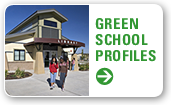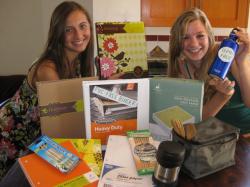A Green Back-to-School
Kids spend a big chunk of their days inside
a school, so it's critical that the school environment:
- has good indoor air quality
- does not expose kids to toxic chemicals
- serves
healthy food
- allows for recess and physical education, and generally promotes health and well-being.
1. Check the Health and Sustainability of your School
One in five people in the U.S. – 55 million children, teachers, administrators, janitors, and nurses – spend their days in K-12 schools. A growing body of research shows that a poor environment at school is detrimental to children’s health and learning. Yet, the U.S. Environmental Protection agency estimates that the environmental conditions in as many as half of all schools is unhealthy.
Check the health, safety, and sustainability of your school using the following helpful checklists and tools:
- Healthy Schools Network - tips on how to get started
- Take the Green Schools Quiz - Find out how green your school is with our online quiz. If you score 31 or higher you may be eligible to be part of our Green Schools Honor Roll.
- Green Cleaners – Use our Green Cleaning Toolkit to get your school to switch to non-toxic cleaners
to improve indoor air quality and reduce asthma and absenteeism.
- Indoor Air Quality App - There’s an App for That from US EPA: a mobile app to assess the indoor air quality at schools and provides access to their Indoor Air Tools for Schools Action Kit. The tool will help identify and prioritize IAQ improvements district wide.
- What is a “green school”
– Check out our "Little Green Schoolhouse" graphic that shows the 4 key
elements of a green school built on the foundation of the Precautionary Principle (Download the graphic as a PDF).
2. Re-use, Recycle, & Buy Environmentally-Friendly Back-to-School Supplies
Your back-to-school purchases make a huge difference. Here's why:
14 billion pencils are produced every year, many made
with wood from ancient forests.
Americans use about
31.5 million tons of printing and writing paper each year, requiring
535 million trees (most from virgin tree fiber) and 12 billion gallons
of oil to make.
The average American consumes about 660 pounds of
paper per year, compared to 550 pounds in Japan and only about 8.8
pounds in India. Some estimates suggest that 400 million used whiteboard markers
-- that's 25,000 tons -- are thrown out in U.S. schools every year,
ending up in landfills. A switch to non-toxic refillable aluminum
whiteboard markers would save money and waste.
Re-use and Recycle:
- Can you reuse binders, pencils, and markers from last year? You might not need to buy much new.
- Buy refillable whiteboard markers and re-use them for years.
- Shop for used binder notebooks at your local re-use agency. In the Bay Area check out East Bay Depot for Creative Reuse - 3-ring notebooks are about 25 cents.
- Buy used clothing at numerous fashionable and funky stores and/or donate your own used clothing. In the Bay Area, check out: Hannah's, Buffalo Exchange, Crossroads Trading Co., Goodwill, Salvation Army, Out of the Closet, and more. You can find info about most of these stores under East Bay Used Children's Clothing. Or look on-line or in the Yellow Pages under "used children's clothing."
- Visit the Green Schools Buying Guide. It's for everyone -- whether you're overhauling school policy or just need to purchase a few reams of paper.
- Center for Health, Environment and Justice – Check out their 2013 Guide to PVC-Free Back-to-School Supplies and their Back-to-School Checklist.
- New American Dream - has 5 tips to simplify back-to-school shopping and also for college students.
- New Leaf Paper - You can find gorgeous New Leaf notebooks, spiral, binders, and paper at Office Depot, Office Max, Kroger, Amazon.com, Target and other retailers.
- The Green Office - (online) Sells supplies with recycled content, fewer hazardous chemicals, PVC-free, and reusability (like refillable pens). New "PVC-free Catalog": they removed nearly 2,000 products containing PVC or vinyl from their old catalog! Enter the coupon code TGOWELCOME at checkout, and receive 10% off your first purchase.
- Office Depot , Office Max, Staples - (in-store or online) Look for recycled content paper and notebook products, green printing supplies; pencils made from certified sustainable-harvest wood; and EnviroTech products, which have a higher recycled content.
- Green Earth Office Supplies - (online only) Sells notebooks, recycled paper, recycled binders (some are made of old circuit boards!), and many other great products such as reusable, biodegradable, non-PVC plastic containers for lunch boxes under the Food Service/Kitchen Supplies tab (containers must be hand-washed).
- Green, Natural Kids' Clothing - Green America's article lays out what to look for and brands and sources for natural, less-toxic clothing materials and fair labor practices.
3. Pack a Waste-Free and Toxics-Free Lunch
Make a waste-free lunch and make a difference! It's
estimated that the average school-age child using a disposable lunch
generates 67 pounds of waste per school year. That's about 18,760
pounds of lunch waste for just one average-size elementary school!
There are 9,000 schools in California alone. And did you know that many
vinyl lunchboxes contain dangerous levels of poisonous lead?
Find out how you can pack a healthy, waste-free lunch:
- Waste Free Lunches - information about how to pack a waste-free lunch and where to get a "laptop lunch box" with reusable containers that neatly fit into a lunch box.
- reuseit.com - provides alternatives to help reduce disposable plastic and paper bag waste. Watch their Waste-Free Lunch video on YouTube.
- Klean Kanteen
- the maker of the original, reusable and non-toxic stainless steel
water bottles offers a 10% discount for school and team fundraising.
Have your school logo put on if you like. Complete the form here.
- Kids Konserve - offers waste free lunch containers.
- Waste-Free Lunch Guidelines - Download this document with helpful waste-free lunch guidelines developed by 4th graders at Prospect Sierra School.
- Lead in Lunchboxes - Learn about how to test your child's lunchbox for lead, find alternatives to vinyl lunchboxes, and join the campaign to stop the manufacture of toxic lunchboxes.
- Healthy Lunches - Get ideas for packing your own healthy lunches from Chef Ann at www.lunchlessons.org or transform the school lunch offered at your school with the Rethinking School Lunch guide from ecoliteracy.org.
- Avoid PVC Plastic - Many Glad (TM) products are made with polypropylene and are PVC-free, including Glad bags, Gladware reusable containers, and Glad plastic wrap. Avoid #3 plastics.
4. Check that your School has a Wellness Policy
In
the Child Nutrition and WIC Reauthorization Act of 2004, Congress required that all school districts with
federally-funded school meals programs develop and implement wellness
policies that address nutrition and physical activity by the start of
the 2006-2007 school year. Ask
your principal if your school district has adopted the required
policy. Find out if the policy promotes nutrition and physical
activity as described by National Alliance for Nutrition and Activity. Click here for model school wellness policies that promote children’s health and well-being.
5. Start a Green School Program at Your School
There's always room for improvement! You can catalyze and support green programs at your school in a variety of ways. Kids love the opportunity to be leaders as they produce tangible results at their schools by reducing, recycling, reusing, composting and building their problem-solving skills. Many “green” schools have reported that their environmental programs have strengthened their school community in unpredictable ways, while creating a healthier environment.
Learn about ways to empower your kids and your school to make a difference:
- Green Schools Initiative Take Action Page - Tips for passing a school board resolution, and 7 Steps to a Green School, can help you get started.
- Check out the many state green schools programs and networks on our Resources page under Green School Programs. Our movement is growing!
- National PTA has a position on School Modernization and Environmental Health and provides tips and resources for ensuring safe and healthy school facilities.
- Green Purchasing Policies - Pass an environmentally friendly-purchasing policy at your school with ideas and sample policies from our Buying Guide. Also see Responsible Purchasing Network and model policies.












